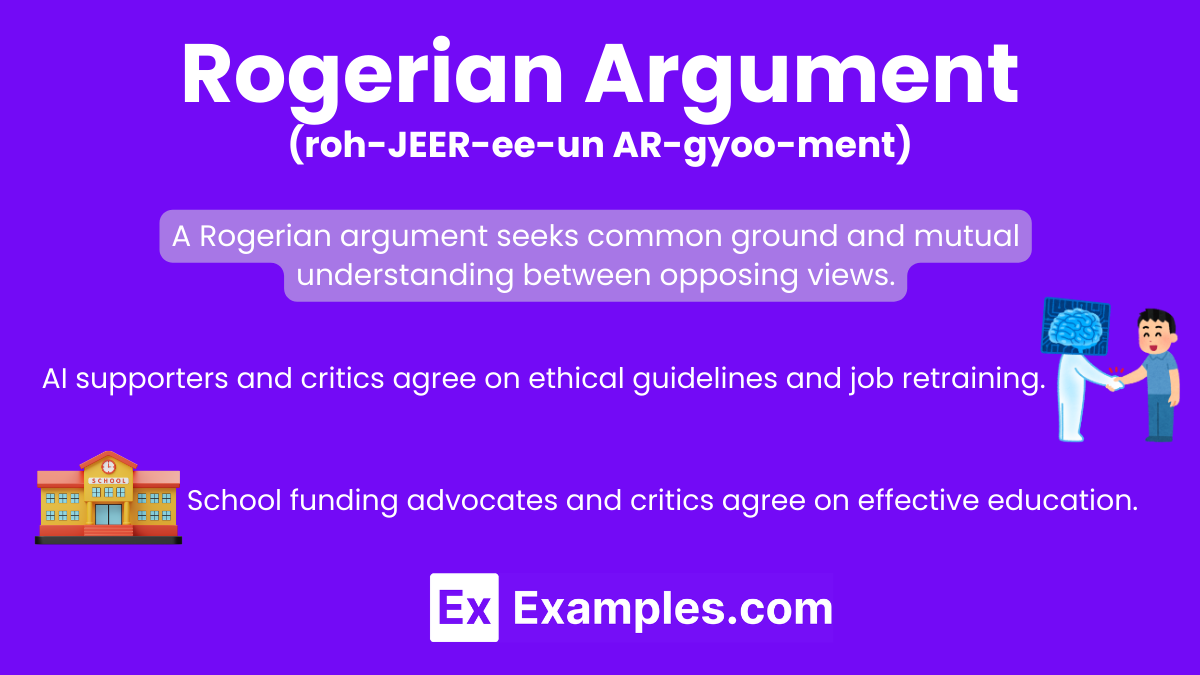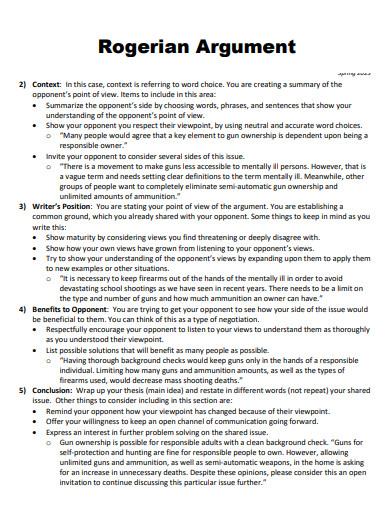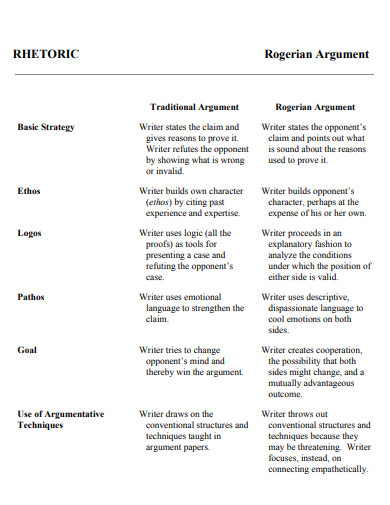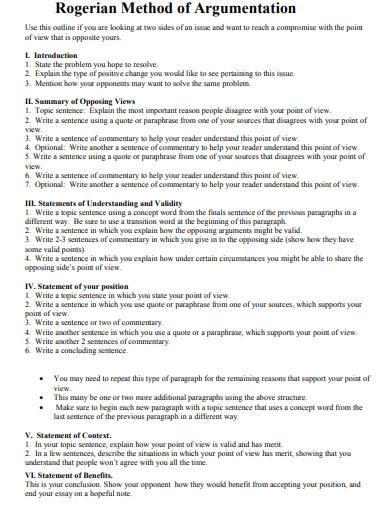40+ Rogerian Argument Examples
A Rogerian Argument is a method of persuasion used in English that focuses on finding common ground and establishing mutual respect between opposing viewpoints. Instead of debating or attacking the other side, this approach encourages open dialogue and understanding, aiming to reach a consensus that acknowledges both perspectives. It uses various rhetorical devices like empathy, active listening, and balanced reasoning to create a more cooperative and less confrontational atmosphere. By valuing each side’s position, a Rogerian Argument fosters a more respectful and productive discussion.
What is the Rogerian Argument?
Examples of Rogerian Argument
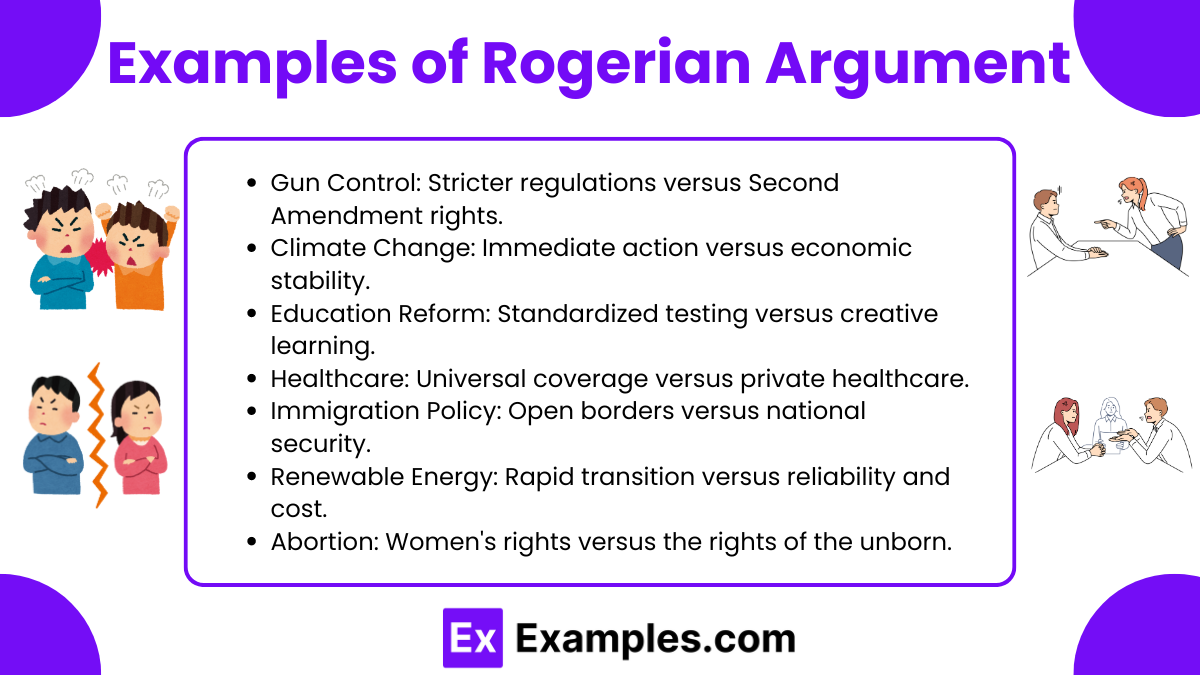
- Gun Control: Stricter regulations versus Second Amendment rights.
- Climate Change: Immediate action versus economic stability.
- Education Reform: Standardized testing versus creative learning.
- Healthcare: Universal coverage versus private healthcare.
- Immigration Policy: Open borders versus national security.
- Renewable Energy: Rapid transition versus reliability and cost.
- Abortion: Women’s rights versus the rights of the unborn.
- Animal Testing: Ethical concerns versus medical advancement.
- Internet Privacy: Stronger data protections versus business needs.
- Minimum Wage: Higher wages versus potential job loss.
- Vaccination: Public health versus personal freedom.
- Capital Punishment: Inhumane practice versus deterrence.
- School Uniforms: Equality and focus versus personal expression.
- Digital Learning: Accessibility versus face-to-face interaction.
- Workplace Diversity: Inclusion versus merit-based hiring.
- Artificial Intelligence: Progress versus job loss and ethics.
- Homelessness Solutions: Housing-first versus comprehensive services.
- Freedom of Speech: Unrestricted expression versus preventing harm.
- School Funding: Increased resources versus taxpayer burden.
- Urban Development: Economic growth versus preserving green spaces.
Examples of Rogerian Argument in a Sentences
- Advocates for gun control and gun rights supporters both agree on the importance of reducing gun violence.
- Environmentalists and industrialists can both support innovations in green technology to balance ecological health and economic growth.
- Proponents of standardized testing and critics of it both aim to improve student outcomes and educational quality.
- Supporters of universal healthcare and private healthcare providers both seek to ensure that people have access to necessary medical treatments.
- Those favoring open borders and those advocating for stricter immigration controls both desire a fair and orderly process.
- Environmental advocates and traditional energy supporters can agree on the need for reliable and affordable energy solutions.
- Pro-choice and pro-life advocates can work together on improving sex education and support systems for women and children.
- Opponents of animal testing and supporters can both advocate for the ethical treatment of animals and the development of alternatives.
- Privacy advocates and businesses can find common ground in promoting transparency and user consent in data collection.
- Those in favor of raising the minimum wage and those concerned about economic impacts can agree on the importance of fair compensation and job sustainability.
Examples of Rogerian Argument in Literature
- “Letter from Birmingham Jail” by Martin Luther King Jr.: King acknowledges the fears of white moderates while advocating for civil rights.
- “A Modest Proposal” by Jonathan Swift: Swift uses satire to find common ground on addressing poverty and overpopulation in Ireland.
- “To Kill a Mockingbird” by Harper Lee: Atticus Finch empathizes with both the town’s racist attitudes and the need for justice.
- “Pride and Prejudice” by Jane Austen: Elizabeth Bennet and Mr. Darcy’s eventual understanding of each other’s perspectives on class and character.
- “Frankenstein” by Mary Shelley: The creature and Victor Frankenstein express their grievances and seek understanding of each other’s suffering.
- “The Crucible” by Arthur Miller: Characters like John Proctor and Reverend Hale strive to understand different views on integrity and hysteria.
- “Catch-22” by Joseph Heller: The novel explores the absurdities of war from multiple perspectives, seeking to highlight the common frustrations of soldiers.
- “1984” by George Orwell: Winston and Julia’s differing views on rebellion and conformity reflect a search for shared humanity in a dystopian world.
- “Beloved” by Toni Morrison: The characters grapple with the legacies of slavery, seeking understanding and reconciliation.
- “The Great Gatsby” by F. Scott Fitzgerald: Gatsby and Nick Carraway’s differing views on the American Dream reveal shared disillusionment.
Rogerian Argument
Rogerian Argument Example
Rhetoric Rogerian Argument
Rogerian Method of Argumentation
Sample Rogerian Argument
How to Craft a Rogerian Argument
When constructing a Rogerian argument, the objective is not to prove one side right and the other wrong, but rather to discover areas of agreement and build a foundation for constructive dialogue. This step-by-step guide outlines the key elements of creating an effective Rogerian argument.
Step 1: Establishing Context and Objectives
Begin by providing a clear context for the issue at hand. Define the topic and identify the objective of the discussion. Clearly articulate the primary concerns of each perspective while avoiding judgment or bias. This step sets the stage for a productive exchange by acknowledging the validity of both viewpoints.
Step 2: Presenting Observations and Goals
Present the observations made by each party involved in the argument. Highlight the direct objects of concern and the goals they aim to achieve. This step helps in recognizing the motivations driving each perspective and demonstrates a willingness to understand their underlying intentions.
Step 3: Identifying Analogies and Literary Devices
Utilize analogies and literary devices to draw parallels between opposing viewpoints. Analogies can highlight shared elements and experiences, fostering a sense of connection between the parties. This literary device can be an essential element in establishing common ground.
Step 4: Revealing Cause and Effect Relationships
Explore the cause and effect relationships that contribute to each viewpoint. Identify correlations between the perspectives and reveal how certain factors might influence the differing opinions. This step encourages the acknowledgment of external influences that shape individual beliefs and attitudes.
What are the three main elements used in a Rogerian argument?
The three main elements are: acknowledging the opposing viewpoint, finding common ground, and proposing a compromise that satisfies both parties.
What is an example of a Rogerian argument?
Gun control advocates and gun rights supporters both agree on reducing gun violence, aiming for policies that ensure safety and respect constitutional rights.
What is a key element of Rogerian argument?
A key element is empathy, understanding the opposing viewpoint to find mutual respect and common ground.
What type of strategy is the Rogerian argument?
The Rogerian argument is a conflict-resolution strategy focused on cooperation and finding mutually beneficial solutions.
How do you start a Rogerian argument?
Start by respectfully acknowledging the validity of the opposing viewpoint before presenting your own perspective.
When would you use a Rogerian argument?
Use a Rogerian argument when discussing highly polarized topics to reduce tension and foster cooperative dialogue.
Why is Rogerian method more effective in raising argument?
The Rogerian method is more effective because it reduces hostility, encourages empathy, and builds consensus through understanding and respect.
What do Rogerian arguments try to avoid?
Rogerian arguments try to avoid aggression, hostility, and outright rejection of the opposing viewpoint.
What is the ethos of Rogerian argument?
The ethos of the Rogerian argument is based on empathy, respect, and collaboration to achieve mutually satisfactory solutions.
What is the difference between classical and Rogerian argument?
Classical arguments focus on winning, while Rogerian arguments emphasize understanding and compromise to reach a common goal.



